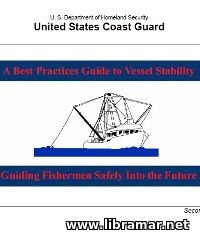
This training document was prepared by the Homeland Security Department of USCG, which maybe is the most authoritative regulatory and control organization in the maritime world. The booklet will provide required guidance in the stability of fishing vessels. The basic stability concepts have been introduced in the pages of this volume which will be practically interesting for the crew members and owners of the fishing ships, as well as to any other parties involved in commercial fishing.
The book will tell the readers about stability, providing them with the answers to such question as how does stability of the vessel work and how is the stability determined. They will understand the difference between initial stability and overall stability and get a lot of other useful information covering a widest range of different subjects related to the stability of the fishing vessels. The authors have listed the most important lessons at the beginning of the sections in order to assist readers.
The readers will also know what they can do to let their vessel maintain adequate stability and understand how the operation of the vessel affects stability. The book was written having crew members and not professional naval architects in mind, so the information is presented in a simple and clear language to make it understandable for everyone on board and ashore.






